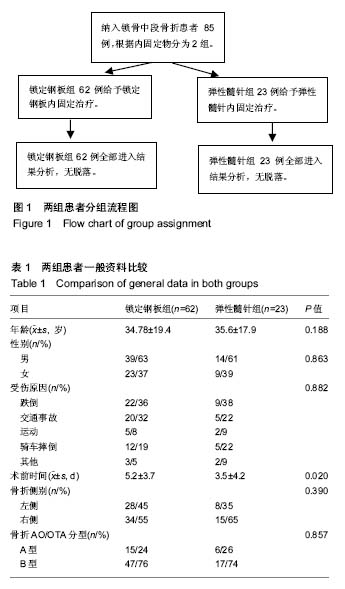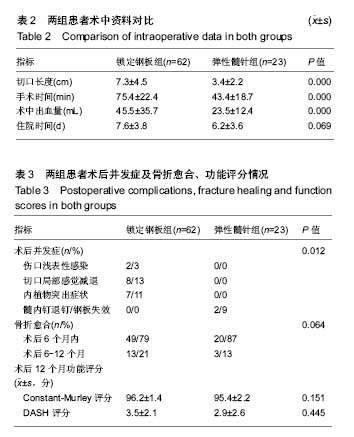| [1] Postacchini F, Gumina S, De Santis P, et al. Epidemiology of clavicle fractures. J Shoulder Elbow Surg. 2002; 11:452-456.[2] Nordqvist A, Petersson C. The incidence of fractures of the clavicle. Clin Orthop Relat Res. 1994:127-132.[3] Govindasamy R, Kasirajan S, Meleppuram JJ, et al. A retrospective study of titanium elastic stable intramedullary nailing in displaced mid-shaft clavicle fractures. Rev Bras Ortop. 2016 ;52(3):270-277. [4] Gummesson C, Ward MM, Atroshi I. The shortened disabilities of the arm, shoulder and hand questionnaire (QuickDASH): validity and reliability based on responses within the full-length DASH. BMC Musculoskelet Disord. 2006;7:44.[5] van der Meijden OA, Houwert RM, Hulsmans M, et al. Operative treatment of dislocated midshaft clavicular fractures: plate or intramedullary nail fixation? A randomized controlled trial. J Bone Joint Surg. 2015; 97:613-619.[6] Angst F, Schwyzer HK, Aeschlimann A, et al. Measures of adult shoulder function: Disabilities of the Arm, Shoulder, and Hand Questionnaire (DASH) and its short version (QuickDASH), Shoulder Pain and Disability Index (SPADI), American Shoulder and Elbow Surgeons (ASES) Society standardized shoulder assessment form, Constant (Murley) Score (CS), Simple Shoulder Test (SST), Oxford Shoulder Score (OSS), Shoulder Disability Questionnaire (SDQ), and Western Ontario Shoulder Instability Index (WOSI). Arthritis Care Res. 2011; 63 Suppl 11:S174-188.[7] Ebrahimzadeh MH, Moradi A, Vahedi E, et al. Validity and Reliability of the Persian Version of Shortened Disabilities of the Arm, Shoulder and Hand Questionnaire (Quick-DASH). Int J Prev Med. 2015;6:59. [8] Constant CR, Gerber C, Emery RJ, et al. A review of the Constant score: modifications and guidelines for its use. J Shoulder Elbow Surg. 2008; 17:355-361.[9] Yao M, Yang L, Cao ZY, et al. Chinese version of the Constant-Murley questionnaire for shoulder pain and disability: a reliability and validation study. Health Qual Life Outcomes. 2017; 15:178.[10] Chachan S, Tudu B, Sahu B. Ultrasound monitoring of fracture healing: is this the end of radiography in fracture follow-ups? J Orthop Trauma. 2015; 29:e133-138.[11] Litrenta J, Tornetta P 3rd, Mehta S, et al. Determination of radiographic healing: an assessment of consistency using RUST and modified RUST in metadiaphyseal fractures. J Orthop Trauma. 2015; 29:516-520.[12] Hill JM, McGuire MH, Crosby LA. Closed treatment of displaced middle-third fractures of the clavicle gives poor results. J Bone Joint Surg. 1997;79:537-539.[13] Khan LA, Bradnock TJ, Scott C, et al. Fractures of the clavicle. J Bone Joint Surg. 2009;91:447-460.[14] Roy JS, MacDermid JC, Woodhouse LJ. A systematic review of the psychometric properties of the Constant-Murley score. J Shoulder Elbow Surg. 2010; 19:157-164.[15] Ledger M, Leeks N, Ackland T, et al. Short malunions of the clavicle: an anatomic and functional study. J Shoulder Elbow Surg. 2005; 14:349-354.[16] Golish SR, Oliviero JA, Francke EI, et al. A biomechanical study of plate versus intramedullary devices for midshaft clavicle fixation. J Orthop Surg Res. 2008; 3:28.[17] Onstenk R, Malessy MJ, Nelissen RG. Brachial plexus injury due to unhealed or wrongly healed clavicular fracture. Ned Tijdschr Geneeskd. 2001;145(50):2440-2443.[18] Bernstein J. Nonoperative treatment compared with plate fixation of displaced midshaft clavicular fractures. J Bone Joint Surg. 2007; 89:1866; author reply 1866-1867.[19] Bostman O, Manninen M, Pihlajamaki H. Complications of plate fixation in fresh displaced midclavicular fractures. J Trauma.1997; 43:778-783.[20] Chen YF, Wei HF, Zhang C, et al. Retrospective comparison of titanium elastic nail (TEN) and reconstruction plate repair of displaced midshaft clavicular fractures. J Shoulder Elbow Surg. 2012; 21:495-501.[21] Poigenfurst J, Rappold G, Fischer W. Plating of fresh clavicular fractures: results of 122 operations. Injury. 1992; 23:237-241.[22] Giddie J, Fisher R, White A. A rare anatomical variant: transosseous supraclavicular nerve identified during clavicle fracture fixation. J Surg Case Rep. 2017;2017(11):rjx230.[23] Strauss EJ, Egol KA, France MA, et al. Complications of intramedullary Hagie pin fixation for acute midshaft clavicle fractures. J Shoulder Elbow Surg. 2007; 16:280-284.[24] Eickhoff A, Fischer M, Gebhard F, et al. Complications after intramedullary stabilization of clavicle fractures. Der Unfallchirurg. 2018.[25] Liu HH, Chang CH, Chia WT, et al. Comparison of plates versus intramedullary nails for fixation of displaced midshaft clavicular fractures. J Trauma. 2010; 69:E82-87.[26] Jorgensen A, Troelsen A, Ban I. Predictors associated with nonunion and symptomatic malunion following non-operative treatment of displaced midshaft clavicle fractures--a systematic review of the literature. Int Orthop. 2014; 38: 2543-2549.[27] van der V, Timmers TK, Broeders I, et al. Displaced clavicle fractures in cyclists: return to athletic activity after anteroinferior plate fixation. Clin J Sport Med. 2017.[28] Andrade-Silva FB, Kojima KE, Joeris A, et al. Single, superiorly placed reconstruction plate compared with flexible intramedullary nailing for midshaft clavicular fractures: a prospective, randomized controlled trial. J Bone Joint Surg. 2015; 97:620-626.[29] Duan X, Zhong G, Cen S, et al. Plating versus intramedullary pin or conservative treatment for midshaft fracture of clavicle: a meta-analysis of randomized controlled trials. J Shoulder Elbow Surg. 2011; 20:1008-1015.[30] Houwert RM, Wijdicks FJ, Steins Bisschop C, et al. Plate fixation versus intramedullary fixation for displaced mid-shaft clavicle fractures: a systematic review. Int Orthop. 2012; 36: 579-585.[31] 张峻玮,聂伟志,陈玲玲,等. 髓内钉与接骨板治疗锁骨中段骨折的前瞻性随机对照研究[J]. 中华创伤骨科杂志, 2016,18(7): 558-563. |
.jpg)



.jpg)